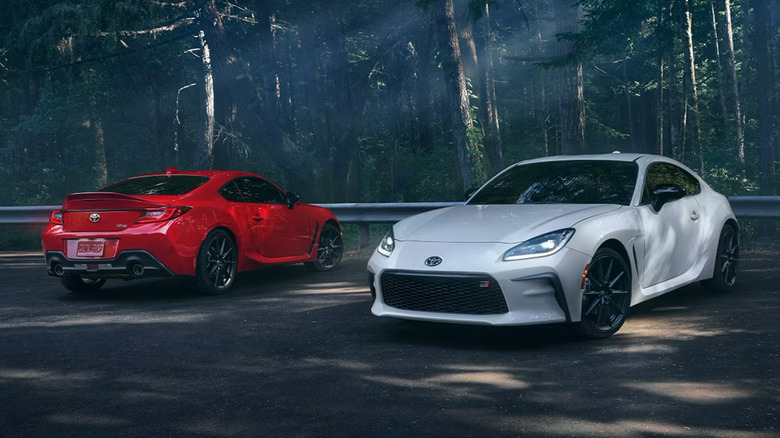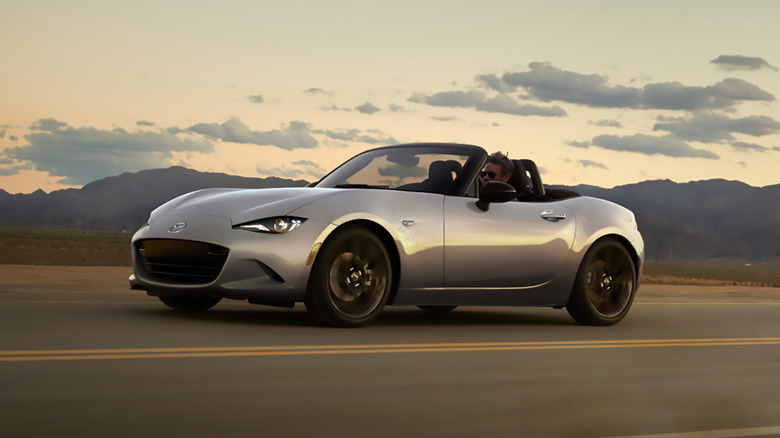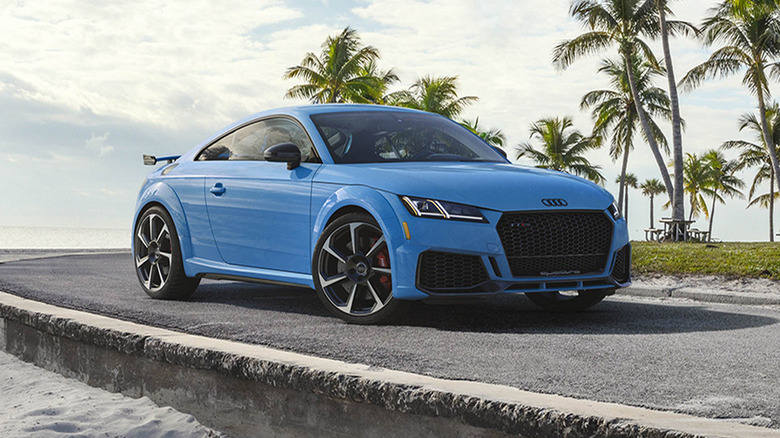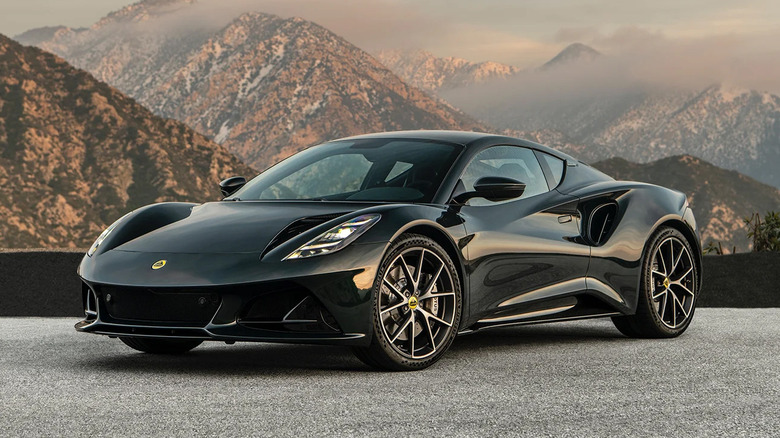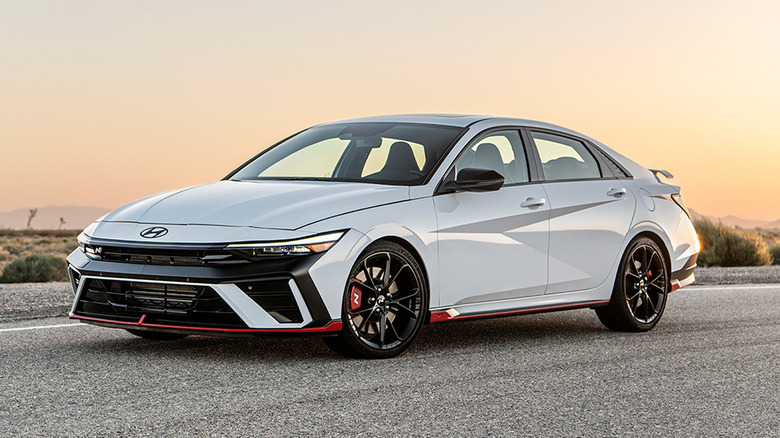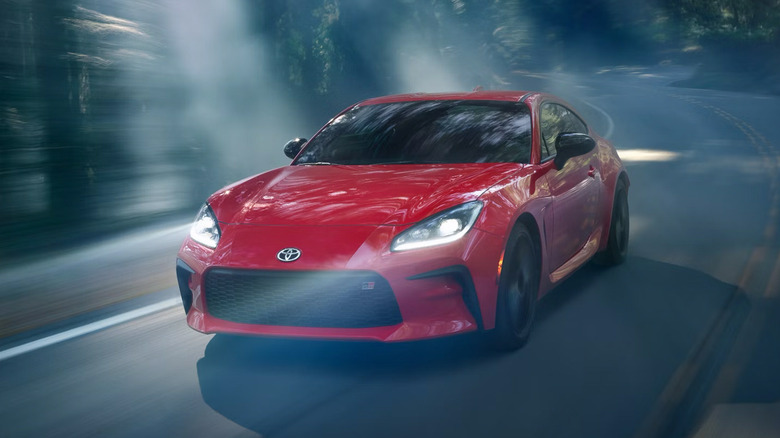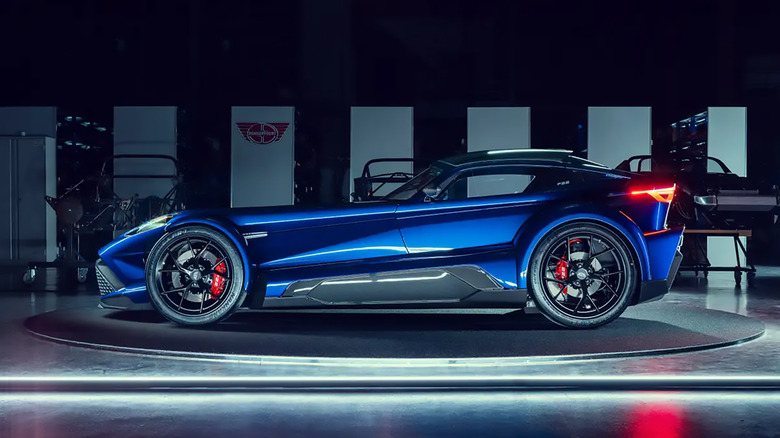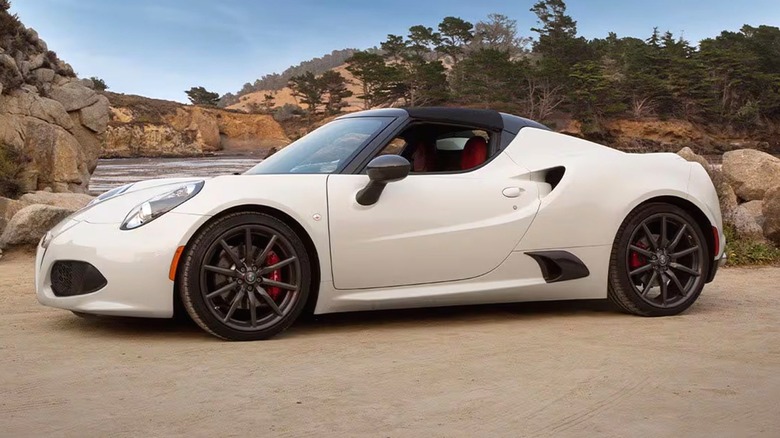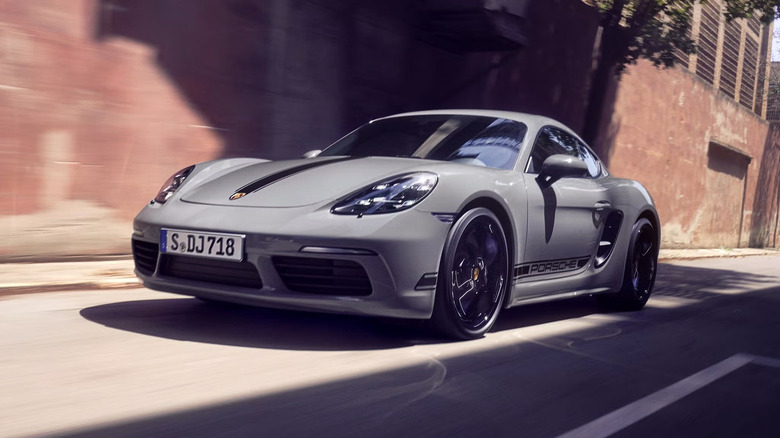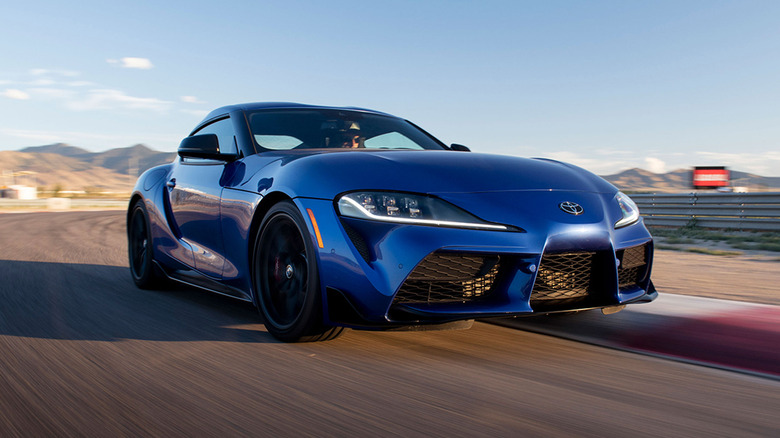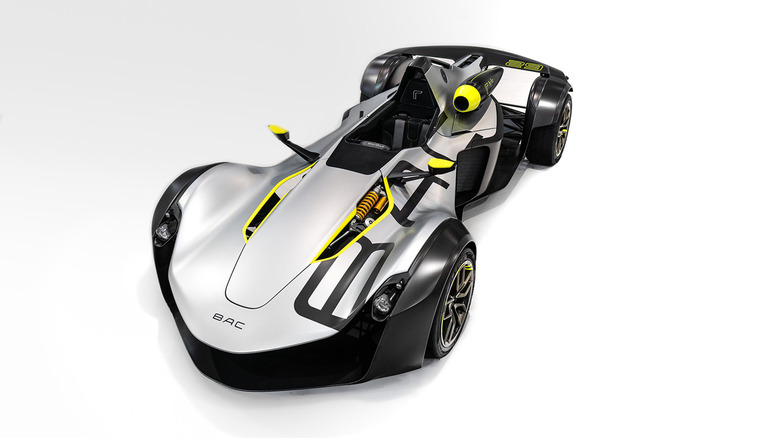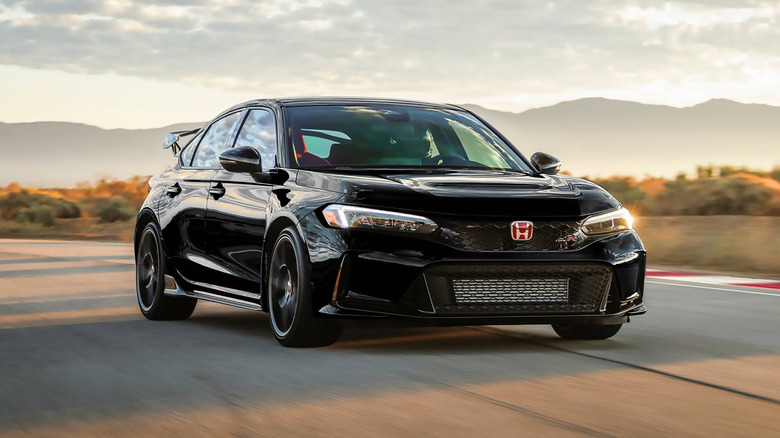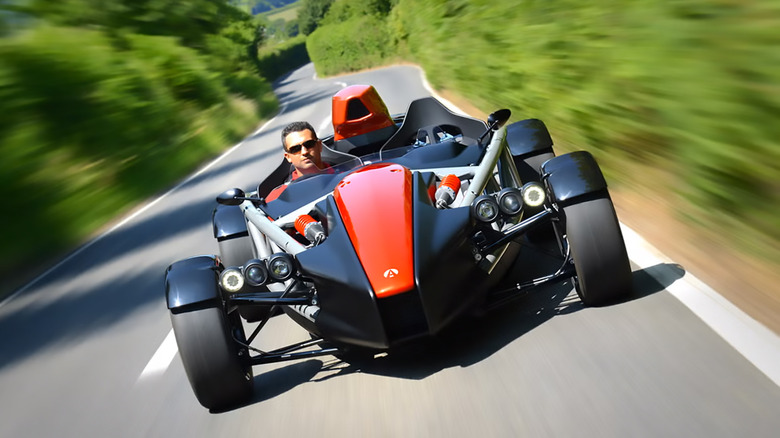13 Of The Lightest Sports Cars That Shred Horsepower Rankings
To keep up in the race for record-breaking top speeds, manufacturers have used large, mind-blowingly powerful engines in their cars that break the boundaries of what we thought a road car was capable of. With the constant evolution of electrified powertrains, so many of today's top sports cars easily approach the high triple figures when it comes to horsepower.
While these cars can reach blistering speeds faster than anything on the road, outright power isn't the only way for cars to come alive. Making a sports car lightweight isn't a new concept; the Koenigsegg One:1 manages to achieve one horsepower for every kilogram of its weight. But at the opposite end of the performance scene, there are plenty of small, lightweight sports cars that offer a power-to-weight ratio good enough to match vehicles that are sometimes much more powerful on paper. Making the thrill of driving relatively accessible, here are 13 sports cars that use their low weight to make up for their relatively modest power output.
2025 Mazda MX-5
The JDM sports cars of the 1980s and 1990s took Japan to new heights on the international automotive stage. While the scene isn't quite as competitive as it once was, there's still a solid choice for JDM sports cars in 2025, with the Mazda MX-5 Miata remaining one of the best value-for-money options if you want a real driver's experience. After being on the market for 35 years, the 2025 MX-5 is still one of the most affordable sports cars available.
Starting at just $29,530 for the soft-top Miata and $37,550 for the RF model (with a $1,235 destination charge), the entry-level sports car is powered by a small 2.0L DOHC four-cylinder, producing 181 horsepower and 151 pound-feet of torque. These numbers may not seem like much, but the MX-5's lightweight construction makes it one of the most engaging cars on the road, particularly on winding roads.
Mazda uses lightweight materials throughout the car, namely aluminum for the engine block and cylinder head. The 2025 MX-5 also uses a monocoque chassis and monotube shocks in the suspension, achieving a curb weight of just 2,366 pounds for the standard Miata and 2,469 pounds in the RF, making it one of the lightest sports cars on the market by a considerable margin. This gives the MX-5 a solid power-to-weight ratio of 0.076 hp/lb.
2022 Audi TT-RS
Another compact sports car that's sadly no longer on the market in 2025 is the Audi TT. What was Audi's smallest sports car fell victim to the gradual transition towards EVs, with its low sales also not helping the TT's case. Still, as it was only discontinued after the 2023 model year, it feels just as modern as key rivals that are still in production, with the RS model packing plenty of performance to take the car into new territory.
The base model was pretty fast, but it was nowhere near what the TT RS was capable of in its final year Stateside. Powered by a turbocharged 2.5L five-cylinder, the 2022 TT RS produces 394 horsepower and 354 pound-feet of torque. These are good numbers for even a larger car, but the 2022 model only weighs 3,296 pounds, allowing for a power-to-weight ratio of 0.120 hp/lb.
A common theme in this type of sports car is to utilize aluminum to save weight, particularly for the engine, and the 2022 TT-RS is no different. Equipped with the quattro all-wheel drive system, it can go from 0-60 mph in just 3.6 seconds, topping out at 155 mph.
2025 Lotus Emira
Producing similar power to the Audi TT-RS, the Lotus Emira has been the key model in maintaining Lotus's position as one of Britain's best performance manufacturers. Introduced in 2021, the Emira has already established itself thanks to its top-tier handling and overall feel, which we loved during our review of the 2024 model.
The 2025 Emira is available in two different guises: the First Edition and the Emira V6. Despite the latter having a larger engine than the former's turbocharged 2.0L four-cylinder, it can't match its overall performance. The Emira First Edition produces 395 horsepower (equal to the V6), but produces 354 pound-feet of torque against the V6's 310 pound-feet rating. This is good enough to get the Emira to 60 mph in 3.8 seconds, with a top speed of 182 mph.
Besides the engine, Lotus uses various techniques to knock off more pounds in the First Edition, primarily through replacing the steel rear subframe with an aluminum one, reducing the weight by some 26.5 pounds. This results in a curb weight of 3,279 pounds and a power-to-weight ratio of 0.120 hp/lb, equal to the newest TT-RS. Pricing for the 2025 Emira comes in at $99,900, earning its price tag through top-tier aerodynamics as well as its raw performance.
2025 Hyundai Elantra N
Hyundai may not be the first brand that you consider for performance cars. Still, the South Korean brand has been establishing itself with the performance N line of vehicles, bolstering several nameplates over the years. The Elantra first got its N variant for the 2022 model year, turning the affordable car into a punchy sports sedan. Hyundai rolled out a styling update for the model in 2024, but not much changed mechanically.
The Veloster N may be discontinued, but its powerplant is kept alive today with the 2025 Elantra N. The engine in question is a turbocharged 2.0L four-cylinder, producing a solid 276 horsepower and 289 pound-feet of torque. With a curb weight of 3,186 pounds, the power-to-weight ratio for the 2025 Elantra N measures at 0.087 hp/lb.
Not quite as good of a ratio as others on this list, but still more than enough to give the sedan sharp handling and punch off the line, going from 0 to 60 mph in 5.1 seconds. Add a modest price tag of $34,350 (with a $1,245 destination charge), and the N performance vehicle is tough to overlook.
2020 Nissan 370Z NISMO
Keeping on topic with the very best JDM cars, Nissan's Z line has stood the test of time like very few other series have managed. The original 240Z, introduced way back in 1969, is without a doubt one of the most crucial sports cars to come out of Japan, setting the stage for not only the rest of the Z line but JDMs in general. Fast forward to 2009, the 370Z was released, which ran until 2020 before the latest Nissan Z took its place. The standard 370Z helped keep Nissan at the top of the affordable sports car scene, but the NISMO version is how you get the most out of the sixth-generation model.
The base 370Z's engine doesn't drop too far from the ratings that the Nismo model offers, with 332 horsepower and 270 pound-feet of torque coming from its 3.7L V6. For over $15,000 more upon its release, the NISMO increased the power output to 350 horsepower and 276 pound-feet of torque. Overall, the 2020 Nissan 370Z NISMO weighs 3,457 pounds, which is on the heavier side for the lightest sports cars. You still get a power-to-weight ratio of 0.1 hp/lb.
2025 Toyota GR86
Ever since the Toyota GT86 and Subaru BRZ were released in 2012, both cars have always been almost identical, with the main differences being some minor design tweaks and chassis tuning. With the Toyota now known as the GR86, both cars are built on the same platform and use the same engine. This doesn't come as much of a surprise due to the cars being a joint effort between the Japanese brands, produced in the same Subaru factory. Despite being almost identical, the GR86 slightly edges the BRZ when it comes to its power-to-weight ratio, earning its spot on this list by a hair.
Regarding the engine, the 2025 GR86 is powered by a naturally aspirated 2.4L flat-four BOXER, an engine Subaru has popularized over the years. This gives the sports car an output of 228 horsepower and 184 pound-feet of torque. The numbers alone are nothing to write home about, but combined with its 2,811-pound curb weight, you get a ratio of 0.08 hp/lb. The 2025 model gets reworked shocks and updated power steering, bolstering its agility in the corners.
2022 Donkervoort F22
When it comes to the most extreme street-legal sports cars that bring the thrill of the racetrack to the road, very few can hold up against what Netherlands-based Donkervoort has produced over the last 50 years. Starting with the S7 model in 1978, the manufacturer only started selling their lightweight sports cars in the U.S. in 2022 with the D8 GTO and its latest model, the F22.
Compared to other cars on this list, the F22 is incredibly limited, with only 100 units produced across the board. Underneath its mere 1,102-pound shell, Donkervoort uses an Audi-derived 2.5L turbocharged inline-five, producing a massive 500 horsepower and 472 pound-feet of torque. These numbers alone are enough to rival cars three times the weight of the F22, but with its ultra-lightweight construction, Donkervoort's latest sports car achieves a power-to-weight ratio of 0.4 hp/lb. Off the line, the F22 can go from 0 to 62 mph in a blistering 2.5 seconds, before reaching its top speed of 180 mph. Despite being so extreme and bare-bones, Donkervoort has still made sure that the open-wheel F22 can be driven every day, with a longer, more comfortable cabin that still holds you in place on the track.
2020 Alfa Romeo 4C
Italian manufacturers like Ferrari, Lamborghini, and Maserati aren't exactly known for producing compact sports cars, at least not in modern times. However, while it was axed from the lineup in 2020, the Alfa Romeo 4C put all the class and excitement you'd expect from an Italian sports car in a tight, well-balanced package that was much more accessible than the elite top speed chasers.
Starting at $67,150, the last Alfa Romeo 4C was priced in the same ballpark as the Porsche 718. It fell behind on power, however, with its turbocharged 1.7L four-cylinder engine producing 237 horsepower and 258 pound-feet of torque. To combat the deficit, Alfa Romeo took weight saving to new heights with its then-flagship sports car, using aluminum throughout the entire engine as well as the chassis. The monocoque is made with carbon fiber, a material that's also used in the rear wing. All together, the 2020 4C came with a weight of 2,487 pounds, resulting in a power-to-weight ratio of 0.095 hp/lb.
2025 Porsche 718
The Alfa Romeo 4C's discontinuation means that there's one less new lightweight sports car for us to choose from, but Porsche has kept the 718 Cayman and Boxster nameplates well and truly alive. Entering the current generation back in 2017, the 718 still remains one of the best compact cars you can buy when it comes to driving dynamics and outright performance.
Porsche has earned an unwavering reputation for expert engineering, extracting every ounce of performance that its cars are capable of. The top-spec GT4 RS model is the pinnacle of this platform, but the lower-output models still come with the tools to uphold that reputation. Under the hood is a turbocharged 2.0L flat-four, producing 300 horsepower and 280 pound-feet of torque. Once again mid-engined, the placement is key for allowing the 718 to rival more powerful sports cars for handling.
With a curb weight of 3,040 pounds, the 2025 718 is markedly lighter than any other Porsche on sale (bar the GT3 RS). This gives Porsche's smallest sports car a solid power-to-weight ratio of 0.098 hp/lb.
2026 Toyota GR Supra
Alongside the GR86, another iconic nameplate also gets the Gazoo Racing treatment to further establish Toyota's authority in the sports car segment. A true icon of the JDM golden years in the 1990s, the Toyota Supra was reintroduced in 2019 after almost 20 years off the market. However, the GR Supra in its current guise will soon be discontinued, but the brand has made sure to give it a proper send-off.
You have the choice between three trims for the 2026 model: the base 3.0, the 3.0 Premium, and the MkV Final Edition. All trims come with the same engine: a turbocharged 3.0L six-cylinder producing 382 horsepower and 368 pound-feet of torque. You can also select a six-speed manual transmission that does not affect its curb weight, which comes in at a solid 3,400 pounds. The car may be heavier than others in its class, but the decent output from the turbocharged powerplant gives the 2025 GR Supra a competitive power-to-weight ratio of 0.112 hp/lb. To get the most out of the car overall, the Final Edition trim comes with performance-tuned suspension, upgraded Brembo brakes, and Alcantara-trimmed sports seats for extra comfort.
2019 BAC Mono R
We mentioned that there aren't many cars that can rival the Donkervoort F22 when it comes to bringing the racetrack to the street, but the BAC Mono is one that arguably surpasses it. The F22's open-wheel design philosophy creates an incredible sense of purity, but the Mono is as close as you can get to a street-legal Formula 1 car with its single-seat, aerodynamic monster of a chassis.
Compared to other cars on this list, the Mono would be at the bottom when it comes to everyday usability, but that isn't what the ultra-lighweight sports car is designed for in the slightest. The base model is already searingly fast, but the Mono R, introduced in 2019, took the single-seater to a new extreme. Powered by a naturally aspirated 2.5L four-cylinder, the BAC Mono R produces 338 horsepower and 243 pound-feet of torque.
Thanks to the car's entire design centering around being as light and aerodynamic as possible, the Mono R consists of carbon-graphene body panels, achieving a curb weight of 1,224 pounds. This gives the Mono R a power-to-weight ratio of 0.276 hp/lb. BAC plans to continue expanding in the U.S., making one of the most extreme road cars on the planet more accessible this side of the pond.
2025 Honda Civic Type R
Unlike Toyota and Nissan, Honda doesn't have its high-performance models compete in the two-door sports car segment. Instead, it takes the four-door hatchback segment by storm with the Civic Type-R. The brand's luxury and performance division, Acura, had the NSX competing in the former segment before it was discontinued in 2022, but that car can't be classed as lightweight against the entries here. The Civic Type-R has been a key model in Honda's lineup for decades, taking one of the most practical, affordable cars and transforming it into one of the most engaging hot hatches on the road today.
Starting at $45,895 with a $1,150 destination charge, the Type-R is notably more expensive than the base model, but it most definitely earns its price tag. A turbocharged 2.0L inline-four supplies the 2025 Type-R with 315 horsepower and 310 pound-feet of torque — a decent amount more than the likes of the GR86 or BRZ. Weighing in at 3,188 pounds, the 2025 Type-R offers a power-to-weight ratio of 0.098 hp/lb, which is more than enough for a car that also makes an ideal daily driver. Lightweight Brembo brakes are also put to good use, along with handy tools such as a limited-slip differential, electric power steering, and MacPherson front suspension to keep it stable through the high-speed turns.
2018 Ariel Atom 4
The Civic Type-R isn't the only car to use its own engine throughout the years. Introduced in 1999, British automaker Ariel made seismic waves with the Atom, a lightweight, stripped-back sports car that falls into the same category as the likes of the BAC Mono and Donkervoort F22. Over the years, the massively exclusive car has received its fair share of updates,
but in 2018, the Atom 4 was released
, marking the largest evolution of the nameplate to date.
Regarding Honda's engine, the Ariel Atom 4, which is still the current generation, put to use the then-current Civic Type-R engine under a completely different shell than the source vehicle. This gave the Atom 4 an output of 315 horsepower and 310 pound-feet of torque, which, in a car weighing 1,312 pounds, offers a driving experience incredibly tough to match. Aluminum was used in the engine, chassis, suspension, and gearbox, helping it achieve its power-to-weight ratio of 0.24 hp/lb. While still limited, Ariel produced some Atom 4's Stateside, but it's still a rarity to see one driving on the road or racetrack.
